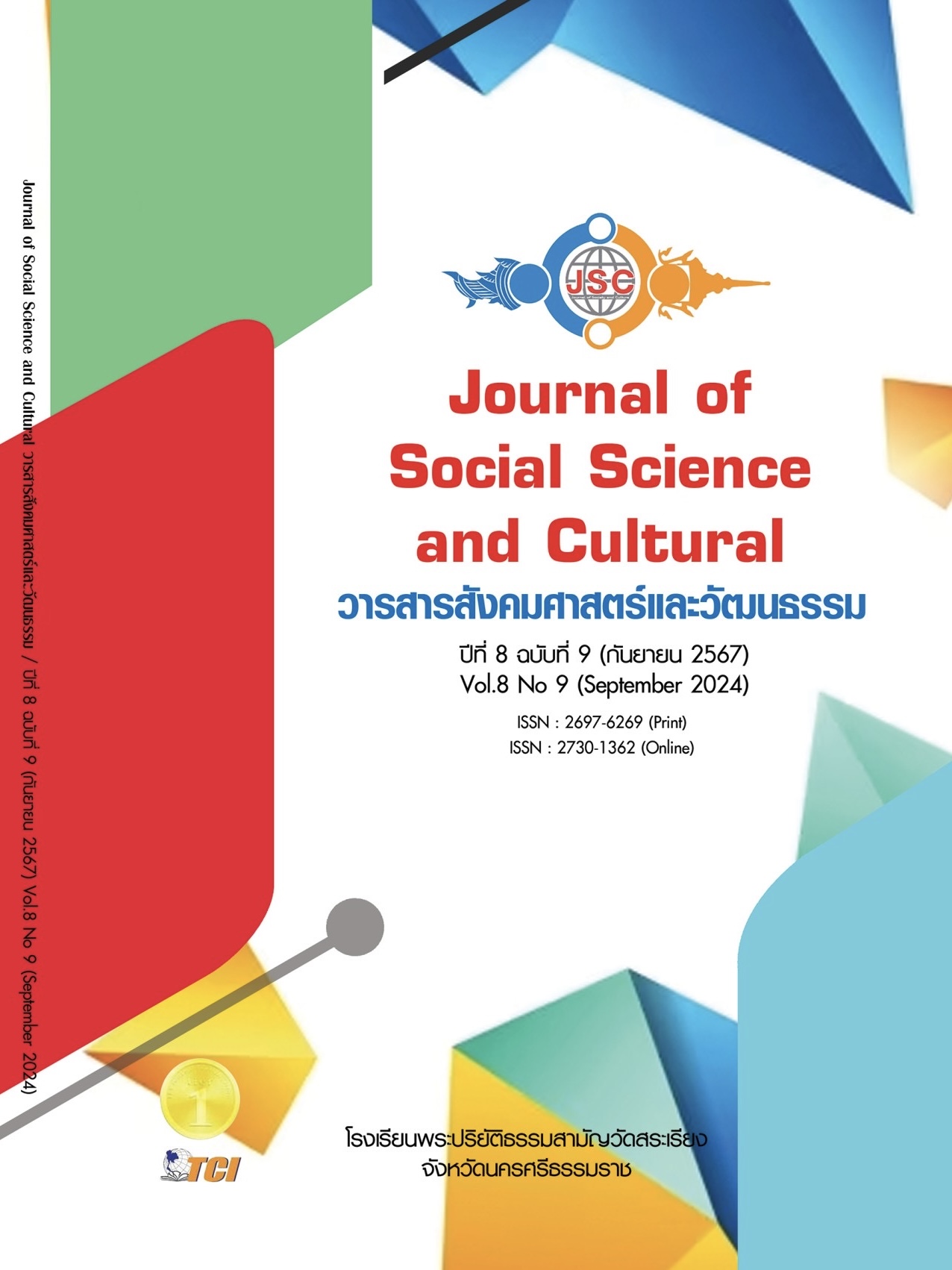THE CREATIVE SOCIAL INTERACTIONS FOR A PEACEFUL SOCIETY ACCORDING TO BUDDHISM
Main Article Content
Abstract
The objectives of this research are as follows: 1) Analyze concepts and theories, 2) Integrate principles, and 3) Build knowledge about "Creative Social Interaction for a Peaceful Society along Buddhist Lines". The results of the study showed that: 1) Actions between two or more things to obtain a positive result, useful or come out in a way that has a negative effect on what is being done, 2) Practice of Buddhist principles, such as the 6 directions: the foreground direction, which is the parents, the right direction, the teacher, the background direction, the husband and wife, the left direction, which is friends, the upper direction, which is the Brahmin monk and the under direction, which is the servant. The body of knowledge stand by the SAM model namely; S = Speech is verbal action, charitable deeds, do not lie, do not speak sly, do not speak profanity, do not speak ill, and do not speak deliriously, A = Action (physical action or honest body) is to do karma with the body, whether it is good or evil, it is called the corrupt body, M = Mind (mental action, conscience), is to do karma by thinking. Whether it is bad karma or good karma, it is called corruption, and the integration of principles about constructive social interaction should encourage the practice of Buddhist principles in order to coexist for Living a life of dependency. There is a bond and a good relationship is created in society.
Article Details
References
จุไรรัตน์ เปรมวรเวทย์. (2556). พฤติกรรมทางสังคม. กรุงเทพมหานคร: โอเดียนสโตร์.
ชัญญรัชต์ บ่อคํา และคณะ. (2565). การปฏิสัมพันธ์เชิงสัญลักษณ์และการสร้างอัตลักษณ์ร่วมในกลุ่ม Street Photo Thailand. วารสารนิเทศศาสตร์และนวัตกรรม นิด้า, 9(1), 87-115.
ชัยมงคล โฆษิตสุริยะพันธ์. (2565). การปฏิสัมพันธ์ทางสังคมและการเรียนรู้ของนักท่องเที่ยวกลุ่มครอบครัว กรณีศึกษา พื้นที่พิเศษเพื่อการท่องเที่ยวเชิงสร้างสรรค์ จังหวัดสุโขทัย. วารสารมนุษยศาสตร์และสังคมศาสตร์ มหาวิทยาลัยราชภัฏพิบูลสงคราม, 16(2), 549-559.
ประภัสสร ชโลธร. (2559). ความสัมพันธ์ระหว่างปฏิสัมพันธ์ของอาจารย์กับนักศึกษาและพฤติกรรมการเรียนของนักศึกษา ในระดับปริญญาตรี คณะครุศาสตร์ มหาวิทยาลัยราชภัฏนครราชสีมา. วารสารชุมชนวิจัย, 10(2), 7-16.
พระเมธาวินัยรส (สุเทพ พุทธจรรยา) และคณะ. (2566). พุทธศาสน์ศึกษาเพื่อการสร้างสังคมสันติสุข. วารสารสิรินธรปริทรรศน์, 24(2), 206-215.
พระใบฎีกากิตติพงษ์ สีลสุทฺโธ และรัชชานนท์ ศุภพงศ์พิเชฐ. (2558). จิตวิทยาสังคมกับการปรับพฤติกรรมการรับรู้ของบุคคลในการดำรงชีวิต. วารสาร มจร. มนุษยศาสตร์ปริทรรศน์, 1(2), 11-22.
พระธรรมปิฎก (ป.อ.ปยุตฺโต). (2546). พจนานุกรมพุทธศาสตร์ ฉบับประมวลศัพท์. (พิมพ์ครั้งที่ 10). กรุงเทพมหานคร: ด่านสุทธาการพิมพ์.
พระมหาปรีดา ขนฺติโสภโณ. (2559). พุทธธรรม: พลังขับเคลื่อนสู่สังคมสันติสุข. ใน รายงานการวิจัย. มหาวิทยาลัยมหาจุฬาลงกรณราชวิทยาลัย.
พระมหาหรรษา ธมฺมหาโส. (2554). พุทธสันติวิธี. กรุงเทพมหานคร: บริษัท 21 เซ็นจูรี่ จำกัด.
วิทิต บัวปรอท. (2564). ทิศ 6 ในพระพุทธศาสนากับการสร้างสัมพันธภาพระหว่างบุคคลในยุค วิถีปกติใหม่. วารสารมหาจุฬานาครทรรศน์, 8(6), 208-221.
สมโภชน์ เอี่ยมสุภาษิต. (2536). ทฤษฎีและเทคนิคการปรับพฤติกรรม. กรุงเทพมหานคร: สำนักพิมพ์สำนักพิมพ์มหาวิทยาลัย.
สุธิรา ชัยรักษา เงินถาวร. (2563). ปฏิสัมพันธ์ทางสังคมผ่านสังคมออนไลน์: กรณีศึกษานักศึกษามหาวิทยาลัยราชภัฏนครศรีธรรมราช. วารสารนาคบุตรปริทรรศน์, 12(1), 76-85.


